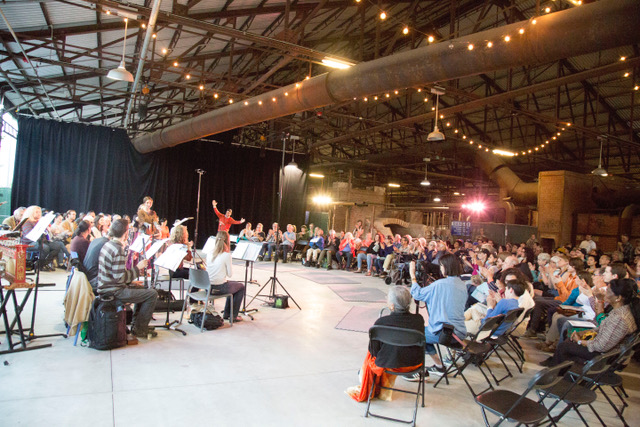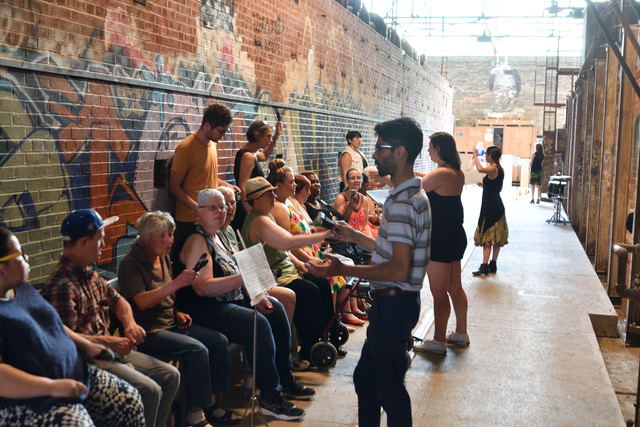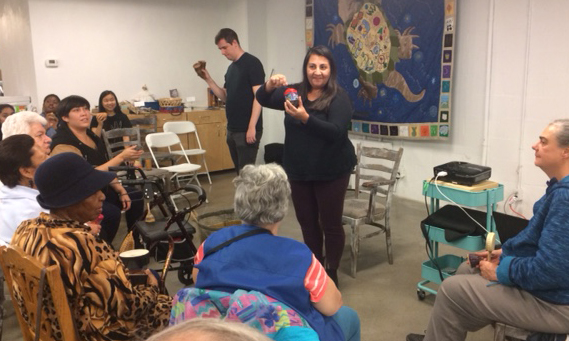Featured Story: Jumblies Theatre
March 2018
 Four Lands at the Evergreen Brick Works, in Collaboration with Continuum Contemporary Music, June 2017. Photo by Liam Coo
Four Lands at the Evergreen Brick Works, in Collaboration with Continuum Contemporary Music, June 2017. Photo by Liam Coo
“We say everyone is welcome! and grapple with the implications – social and aesthetic – of meaning (or trying to mean) it.” This is the approach of Jumblies Theatre, a community-engaged arts organization that exists to bring people together, across real and perceived differences, through meaningful and high calibre art-making. Such an objective is not without its challenges, as the above statement acknowledges. “There are always people who can get left out or who are challenging to include for one reason or another,” states Ruth Howard, founder and Artistic Director of the organization. Yet the staff at Jumblies go to great lengths to live up to this mandate of inclusion, by working with groups to build trust, ensuring that staff and participants have the resources available to engage in meaningful dialogue, and/or allowing for elasticity in the artistic process.
Community-engaged arts involves professional artists collaborating with a group of people – community participants – in the creation and presentation of artwork. It can incorporate and combine one or more art or creative practices - music, dance, theatre, visual arts, storytelling, video, food, textiles - and facilitates a powerful sense of inclusion, self-expression, new relationships and understanding among participants. Toronto Arts Council first created a Community Arts funding program (then called Arts in Community) in 1999. In 2017, TAC distributed over $1 million in funding to 78 community arts organizations and collectives, including Jumblies.
The scope of community-engaged arts in Toronto has changed since Jumblies was first founded in 2001; much of that has to do with the evolving and seminal work of Jumblies itself. Growing from Howard’s involvement in the “community play” form, the organization first undertook a series of neighbourhood residencies (including Davenport Perth, Central Etobicoke, and East Scarborough) which culminated in large-scale interdisciplinary performances following extensive research, development and creation phases. Through subsequent phases of legacy and sustainability, a series of independently-incorporated offshoots were sparked, including Arts4All, MABELLEarts and the Community Arts Guild, as well as other organizations inspired by Jumblies, such as Making Room Community Arts.
 Touching Ground Sounds Workshop, in partnership with Continuum Contemporary Music: music by Jason Doell with guest conductor Hussein Janmohamed. Evergreen Brick Works, June 2016. Photo by Liam Coo
Touching Ground Sounds Workshop, in partnership with Continuum Contemporary Music: music by Jason Doell with guest conductor Hussein Janmohamed. Evergreen Brick Works, June 2016. Photo by Liam Coo
Providing learning opportunities and mentorship for projects and organizations, and supporting leadership and self-reliance for artists, including Indigenous and culturally diverse artists and artists of colour has become a focal point for Jumblies. A shift to a more fully interdisciplinary style led to the development of new forms, such as “Evolving Galleries,” while new partnerships and collaborations expanded its network beyond local neighbourhoods. The success of a two-month coast to coast tour entitled Train of Thought (2015) is an example of this: 75 artists travelled to 25 locations to engage in collaborations and alliances between First Nations, settler and immigrant artists and communities in partnership with local community arts organizations. Through ceremonies of arrival and departure, community workshops, festive meals, performances (sometimes on trains), music and more, the project’s art consisted of the relationships and discoveries that happened along the journey.
Ruth Howard and Jumblies have embraced collaboration with many groups over the years, including arts organizations that don’t typically focus on community engagement. Relationships forged with contemporary music organizations (Soundstreams, Continuum Contemporary Music, Canadian Music Centre for example) stand out. It’s clear that music holds prominence for Howard: “If I could only have one other artist or co-facilitator in a workshop, event or project, I would almost always choose a musician,” she explains. Musicians are often featured in Jumblies’ workshops and development processes, helping to inspire and underscore group creations. In Jumblies’ most recent collaborative project, Round the Table, 7 composers/song-writers were commissioned to create original rounds from text generated by artists and community members. The project culminated in a “performative meal” where the music was presented by Jumblies’ mixed-age and mixed-ability choir, and participants enjoyed soup, sewing, ceramics and storytelling.
 Rehearsal at The Ground Floor, with Composer/Musician Alejandra Nuñez and the Jumblies community choir, January 2018
Rehearsal at The Ground Floor, with Composer/Musician Alejandra Nuñez and the Jumblies community choir, January 2018
These collaborations and partnerships between different art practices inspire new ideas, perspectives, and understandings. Unhampered by differing styles and protocols, all parties learn and adapt to ensure a fruitful relationship and outcome. While musicians and composers are often challenged to be responsive, to improvise, and create works that can be successfully realized by a spectrum of musical abilities, it’s Jumblies’ role to ensure there’s a well-structured rehearsal process and supportive staff.
“Artists, organizations and funding bodies are becoming ever more aware of a need for diversity and inclusion – both for ethical and survival reasons,” says Howard. This is why, in collaborating with musical and other professional artists and partners, it’s Jumblies’ goal to “infiltrate community arts practice into the cultural mainstream.” By encouraging dialogue, collaborative exploration and creation in its many forms, it not only creates a welcoming space, but, as Howard points out, it urges those involved to ask questions: “who might we be leaving out? How might we invite them? Whose help and collaboration can we solicit to learn how to do so?”
Learn more about Jumblies by visiting their website: www.jumbliestheatre.org
Jumblies Theatre receives Operating funding from Toronto Arts Council through the Community Arts portfolio.
Public funding for the arts helps to support community arts organizations like Jumblies Theatre. Let your political representatives know that you support the arts.